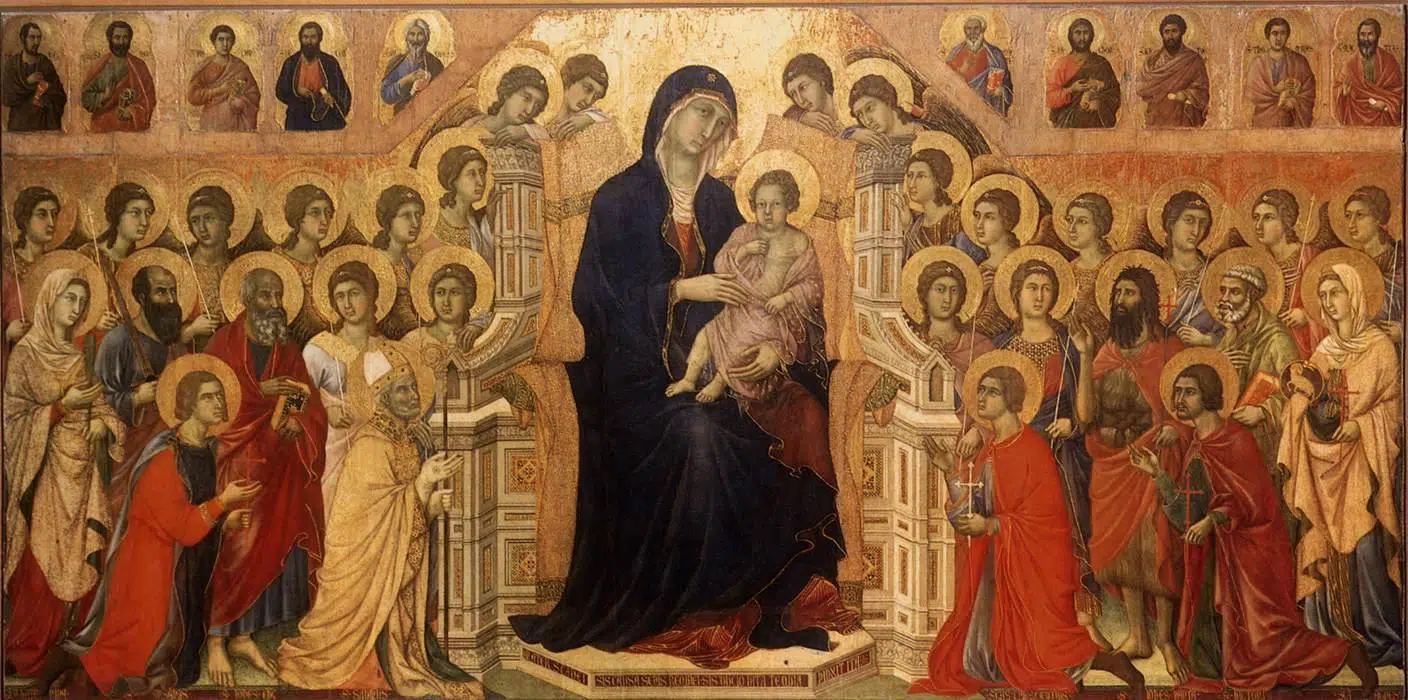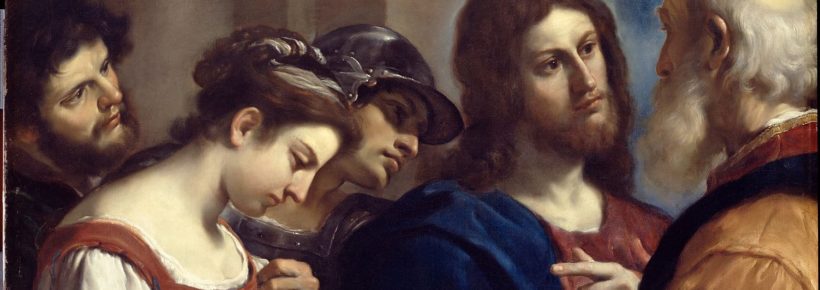Previous articles in this series:
- What Is the Theology of the Body?
- Human Dignity and the Conjugal Meaning of the Body
- The Beginning: The Original Unity of Man and Woman
Next articles in this series:
- Resurrection of the Body
- Christian Virginity and Celibacy for the Kingdom of God
- The Sacrament of Marriage
- Love and Fertility
In our previous article we addressed the topic of the unity of man and woman as they were first created, drawing from the first cycle of catechesis (1-23) of St. John Paul II on the theology of the body. This article addresses the second cycle of the Holy Father’s catechesis (24-63) on purity of heart.
The subtopics we are going to cover in this article are:
- Why purity of heart is the subject of the second cycle
- Why Jesus rejects a legalistic conception of purity
- Old Testament traditions that paved the way for Jesus’ teaching
- The Gospel “ethos” that is needed to achieve purity of heart
- Why Jesus spoke of a man who looks lustfully at a woman, and not vice versa
- Can a man look lustfully at his own wife?
- How St. Paul’s concept of purity complements that of Jesus
- The social role of the virtue of chastity
1. Why does St. John Paul II approach the topic of purity of heart in this second cycle?
The Pope wants to follow the teaching of Christ on the new person He wants us to be. St. Paul says: “Therefore, if anyone is in Christ, he is a new creation; the old has passed away, behold, the new has come” (2 Corinthians 5:17). Christ wants us to be renewed in our interior life so that our bodily life truly expresses physically this renewal of our spiritual life
Now, in the Bible, the interior seat of the spiritual and moral life is called the “heart.” According to the Word of God, the heart is “the depths of one’s being, where the person decides for or against God” (CCC 368). Christ wants to purify our hearts with His teachings and His grace, so that our lives really express the abundance of justice (holiness or righteousness) God wants from us.
In our previous reflections we saw how God created man and woman for marriage. We also saw how Christ wants us to return to the original unity of man and woman in all its purity and richness, restoring the unity and indissolubility of marriage. That is essentially what he taught in Matthew 19:3-6, the key passage of the previous cycle. The man-woman relationship in marriage, therefore, is the key or model for the human person’s correct relationship with God and others. But that relationship begins in the heart.
Therefore, the key passage which is going to be the object of reflection in this second cycle is Matthew 5:27-28: “You have heard that it was said, ‘You shall not commit adultery.’ But I say to you that everyone who looks at a woman lustfully has already committed adultery with her in his heart.”
Jesus taught that without a purification of the heart the external observance of the Sixth Commandment, that prohibited adultery would not make man or woman truly just or holy in the eyes of God. Therefore, He alerted us of a wrong interpretation of the Law and the Prophets – an interpretation of the Commandments that reduced them to their exterior observance, a legalistic interpretation. This interpretation was typical of many of the religious leaders of Israel at the time of Jesus. That is why Jesus warned: “For I tell you, unless your righteousness exceeds that of the scribes and Pharisees, you will never enter the Kingdom of Heaven” (5:20).

Sermon on the Mount (Carl Heinrich Bloch)
2. What is the legalistic interpretation of purity that Christ rejects?
Since the beginning of the history of Israel, the Patriarchs departed from the original meaning of marriage as one and indissoluble by the practice of polygamy (see Genesis, chapters 16, 25, 29, etc.). Even though polygamy was never popular among the People of God, it was never condemned as a violation of the prohibition of adultery. The reason for this was that Israelites respected the Patriarchs very much and considered them sincerely religious. The Patriarchs and other polygamists of Israel (for example, Kings David and Solomon) did not mistreat their wives. But that benevolence did nothing to help restore the true and original meaning of marriage.
The problem was that this practice led to a very legalistic conception of marriage and thus of adultery. In the legal tradition of the Old Testament, adultery was considered as an infraction of the right to property. Polygamists owned their wives. Therefore, adultery was reduced to having a sexual relationship with a legal wife of another man, who could legally have more than one spouse.
This legalistic interpretation also damaged the correct interpretation of the Ninth Commandment: “You shall not covet your neighbor’s wife” (Exodus 20:17). Notice that in this same verse other objects of property not to be coveted are the neighbor’s house, ox, or donkey, etc. The external interpretation of the prohibition of adultery as a violation of the right to property was logically unable to produce a purity of heart capable of resisting the interior act of coveting, adultery, impurity, or lust. Jesus realized this and sought to restore the true meaning of the Sixth Commandment and, by implication, the original meaning of the covenant of marriage. This original meaning of marriage necessarily included the purity of heart as its interior protector against adultery, coveting, impurity, and lust.
3. What other Old Testament traditions revealed the interior dimension of the act of adultery?
There were two traditions in the Old Testament that, even though imperfect, did pave the way for Jesus’ teaching against adultery and impurity, and in favor of the original meaning of marriage: the tradition of the prophets and the wisdom literature.
The Prophetic Tradition
The prophetic tradition aimed at restoring Israel’s fidelity to the Covenant with God (also called Yahweh). Yahweh promised Israel His protection, a new land, and abundance to satisfy the people’s needs. Israel in turn promised obedience to the Ten Commandments that God had given them through Moses (see Deuteronomy, chapter 5).
But the prophets realized that Israel had violated the very First Commandment of the Law of God by going after other gods and worshiping their idols. The special characteristic of this tradition is that the prophets compared idolatry to adultery. This analogy in turn implied the use of the analogy of marriage between a man a woman to illustrate the covenant between Yahweh and Israel.

Moses with the Ten Commandments (Philippe de Champaigne)
Yahweh always loved Israel as His spouse, but sometimes Israel betrayed this love by worshiping other gods. In those cases, Yahweh punished Israel to make her realize her sins and come to her senses. “And I will punish her [Israel] for the feast days of the Baals [pagan gods] when she burned incense to them and decked herself with her ring and jewelry, and went after her lovers, and forgot me, says the Lord” (Hosea 2:13).
But once Israel repented, Yahweh received her again as His spouse:
“Do not be afraid; you will not be put to shame. Do not fear disgrace; you will not be humiliated. You will forget the shame of your youth and remember no more the reproach of your widowhood. For your Maker is your husband – the LORD Almighty is his name – the Holy One of Israel is your Redeemer; he is called the God of all the earth. The LORD will call you back as if you were a wife deserted and distressed in spirit- a wife who married young, only to be rejected,” says your God. “For a brief moment I abandoned you, but with deep compassion I will bring you back. In a surge of anger, I hid my face from you for a moment, but with everlasting kindness I will have compassion on you, says the LORD your Redeemer.” (Isaiah 54:4-8)
The importance of this tradition is that by illustrating the covenantal marriage between Yahweh and Israel by means of the marriage between a man and a woman, the prophets prepared the way for Christ to fully restore marriage as one (monogamy) and indissoluble (fidelity). Indeed, under this prophetic tradition it would be a monstrosity to consider that Yahweh would have several wives or that His love for Israel was something less than faithful.
In addition, under the prophetic tradition, adultery could be correctly defined as a sexual act between a man and a woman in which at least one of them was married to somebody else. This definition qualified adultery as a sin of the body. Even though the interior dimension of this sin was not emphasized, it was not left aside either, and in fact it opened the way to another Old Testament tradition that did emphasize, and very clearly condemned, the interior acts of adultery, lust, and impurity: the wisdom literature (Wisdom, Sirach, Proverbs, Ecclesiastes, Job, Psalms, Song of Songs).
The Wisdom Literature
The wisdom literature, although imperfectly, did warn severely against the adulterous look and the interior lustful desire of a man (specially a young man) towards “an evil woman.” For example, there is the following passage from the Book of Proverbs:
For the commandment is a lamp and the teaching a light, and the reproofs of discipline are the way of life, to preserve you from the evil woman, from the smooth tongue of the adventuress. Do not desire her beauty in your heart, and do not let her capture you with her eyelashes; for a harlot may be hired for a loaf of bread, but an adulteress stalks a man’s very life. (Proverbs 6:23-26; see also Sirach 9:1-9)
The wisdom literature did not always consider the woman a seducer or a harlot. It also praises the good wife, as in this passage from the Book of Sirach:
Happy is the husband of a good wife; the number of his days will be doubled. A loyal wife rejoices her husband, and he will complete his years in peace. A good wife is a great blessing; she will be granted among the blessings of the man who fears the Lord. Whether rich or poor, his heart is glad, and at all times his face is cheerful. (Sirach 26:1-4; see also Proverbs 31:10-31)
However, the wisdom literature did not provide a corresponding ethos to counterattack the lustful, adulterous, and impure tendencies in a man’s heart. By “ethos” is meant the set of values and virtues that should be in the interior of a human heart that is pure. We will have to wait till Jesus’ teaching to discover this ethos.
Nevertheless, despite its shortcomings, the wisdom literature did pave the way for Christ’s teachings on the purity of heart.
4. How can we discover the Gospel “ethos” in Jesus’ condemnation of adultery of the heart?
Jesus’ condemnation of adultery of the heart in Matthew 5:27-28 is not just a condemnation, but rather a call to everyone’s heart to discover the reverse of what He is condemning. However, to make this discovery we need to take a look at the distortions that concupiscence has caused to the original conjugal meaning of the body.
Recall that the original conjugal meaning of the body consisted in the capacity that God inscribed in the human body to be a visible sign of God’s invisible love for His creation and, in particular, for man and woman. The body was also meant to be a physical sign and expression of man’s love for his neighbor. In this sense, we speak of the personal meaning of the body, that the human body was meant to reveal the human person precisely as a person and not as an object or something impersonal.
In the case of marriage, we speak of the conjugal meaning of the body: the capacity God has inscribed in the bodies of man and woman to express to each other their conjugal love always opened to life. The body of the woman was meant to express her true femininity to man, and the body of the man his true masculinity to woman.
However, original sin distorted by means of concupiscence the original meaning of the human body as designed by God. Concupiscence distorted the original meaning of the body by misdirecting the look and the desire of the human person. This misdirection consisted in changing the intentionality of the human person towards others from looking at them as persons to looking at them and desiring them as objects.
In the case of a man looking with unbridled lust at a woman, we are witnessing a complete change of intentionality. The man who looks at a woman in this way not only wants to appropriate her as an object of his lustful desires but can even fall into the extreme of thinking that all women want to be looked at and desired in this way by men. His change of intentionality (from the purity of original innocence to the impurity of original sin) is such that he has completely redefined human existence to suit his evil desires.
5. Why does Jesus speak of a man who looks lustfully at a woman, not vice versa?
Jesus knew that the lustful or impure look can also be a look from a woman to a man. But he emphasized the situation of a man looking at a woman, because the distortion caused by concupiscence works in a kind of different way in man and woman. The descriptions of the effects of original sin in the man-woman relationship in the wisdom passages we just cited above indicate this difference.
In both cases, man treats woman as an object of selfish desire and woman treats man as an object of selfish desire. But the predominant tendency in man is to look and desire the woman as an object of pleasure for himself, whereas the predominant tendency of woman is to become herself an object to be looked at and desired by man. In both cases, we are dealing with a terrible process of objectification and of de-personalization of the human being.
6. Why does Jesus speak of a man who looks lustfully at a woman and not his wife?
Jesus is very consistent in his teaching. If a sexual desire is misdirected by concupiscence, then this distortion can also occur within marriage. If we allow sexual relations within marriage to be “an escape” to gratify concupiscence, then how can we speak of the purity of the conjugal act? Or how can we speak of the redemption of the body that Christ also wants to effect in us? How can we be in both body and soul the new human persons Jesus wants us to be?
We cannot give up our process of sanctification by caving to concupiscence, which is, recall, the inclination to sin that was caused by original sin. (For a fuller account of concupiscence in its threefold manifestation, see 1 John 2:16-17.)
The ethos that Jesus wants to teach us is for both body and soul. But such ethos must begin in the heart. The purity of heart Christ wants us to have is described in reverse by Jesus’ description of impurity: “For out of the heart come evil thoughts, murder, adultery, fornication, theft, false witness, slander. These are what defile a man; but to eat with unwashed hands does not defile a man” (Matthew 15:19-20).
Notice that impurity (defilement) is not limited to sexuality, but actually refers to the distortions caused by concupiscence in all areas of our moral life. Likewise, purity of heart refers to all areas of our moral life. Purity of heart is purity of intention, and purity of intention is fundamentally looking and treating others as persons, as ends in themselves, as gifts of God. Purity of heart is nothing else than pure love springing from the heart, to love others for themselves and not for the sake of our selfish desires. The opposite of purity is not only impurity but hypocrisy. The latter vice consists essentially in not loving others for their own sake, but for our selfish motives. Jesus hated hypocrisy, especially when it distorted our religious duties (see Matthew chapter 23).
Notice also how Jesus rejects the old tradition that reduced purity to its legal meaning, which consisted in washing one’s hands with water. Indeed, purity has to do with cleansing. But notice also how Jesus rejected a legalistic reduction of the virtue of purity by limiting it to the washing of hands. Purity indeed has to do with cleansing, but of the heart, not of the exterior part of the person. A pure heart is a clean heart, clean of concupiscence and all evil. The clean heart will be able to see others as gifts of God, as images of God. Moreover, the clean heart will be able to see God Himself in Heaven. “Blessed are the pure of heart, for they shall see God” (Matthew 5:8).
7. What is St. Paul’s concept of purity and how does it complement Jesus’ concept?
St. Paul does not speak of purity in his letters, but he does condemn impurity and speaks of self-control, especially in relationship to the body. “For this is the will of God, your sanctification: that you abstain from all immorality [impurity]; that each one of you know how to control his own body in holiness and honor” (1 Thessalonians 4:3-4). We can deduce from this teaching that for St. Paul, purity is a virtue because it is the capacity to control one’s own bodily passions.

Saint Paul (Philippe de Champaigne)
St. Paul also connects the concept of purity to the human body in his use of the body as an analogy for the Church, the Body of Christ. This conception appears in 1 Corinthians 12:18-25 and in 1 Corinthians 6:19, where he says that the body is “a temple of the Holy Spirit.” Here, St. Paul is teaching that the human body of the Christian possesses a profound value. In this sense, the virtue of purity also has a positive role: to maintain the body pure by rejecting impurity and thus respect its profound value.
Following this line of thinking, the gift of piety of the Holy Spirit (see Isaiah 11:1-2) is a kind of extension of the gift of fear of the Lord. This latter gift means that we must respect God and the things of God, and the gift of piety extends this respect to the rest of creation, especially the human body and more especially even in the context of Christian marriage. In this way, the virtue of purity is aided by the gift of piety in keeping heart and body pure.
8. What is the social role of the virtue of chastity?
The virtue of purity of heart makes possible the virtue of chastity, which is the correct use of human sexuality. This correct use of human sexuality consists basically in the respect for the inseparable connection between its two inherent meanings: the unitive and the procreative meanings within marriage. See the prophetic Encyclical Humanae Vitae of Pope Paul VI, no. 12.
The virtue of purity and the gift of piety help the virtue of chastity accomplish its goal both within and outside of marriage. Within marriage the virtue of chastity is lived in the loving way open to life with which married couples unite themselves. It also provides the strength for them to practice periodic continence when they have serious reasons to postpone a pregnancy. Outside of marriage, the virtue of chastity is practiced by means of continence, total abstention of sexual relations.
In short, the virtue of chastity has an important social role. In Humanae Vitae, no. 22, Paul VI makes a call “to create an atmosphere favorable to the growth of chastity so that true liberty may prevail over license and the norms of the moral law may be fully safeguarded.” This call is directed not only to families, but also to teachers, politicians, members of media, people involved in the arts, and so on.
Conclusion
“You have dealt with purity of heart, but doesn’t this topic also include purity of the body?”
That is absolutely true. That is why our next article will deal with the resurrection of the body, which is the central topic of the next cycle of the catechesis of St. John Paul II.
The Holy Father deals with the resurrection of the body in cycle 3 because just as Jesus gives a new ethos for the heart, He also gives us a new ethos for the body. The redemption of the heart and of the soul needs to be completed by the redemption of the body. But the redemption of our bodies has not been completed yet. It will only reach its fulfillment in Heaven, with the resurrection of our bodies.

Madonna with Angels and Saints (Duccio di Buoninsegna)
Just as Genesis 1-2 enlightened us about the original innocence of the body, the resurrection of the body as revealed in the Word of God will enlighten us about the final state of our bodies in Eternal Life. God’s teachings on the resurrection of the body, as explained by St. John Paul II, will shed light on our present life as we work out the redemption of our bodies under the power of God’s grace.
Finally, since the human person is a composite of body and soul, it is fitting that after treating of the redemption of the heart (which is the center of the soul), we treat of the redemption of the body, whose definitive state will be the resurrected human body in Heaven. The resurrected human body will attain a glorious state similar to that of Jesus Himself (see Philippians 3:21). Then and only then will we finally become the human persons Christ wanted us to be.
Previous articles in this series:
- What Is the Theology of the Body?
- Human Dignity and the Conjugal Meaning of the Body
- The Beginning: The Original Unity of Man and Woman
Next articles in this series:
Related Content
Adolfo is the Director of Education for Hispanic Outreach for Human Life International and of HLI's Hispanic outreach arm Vida Humana Internacional. He has a Masters in Theology from St. Vincent de Paul Regional (Major) Seminary and a License in Moral Theology from the Alphonsian Academy in Rome.
Adolfo has traveled frequently to VHI’s affiliates in Latin America to give talks, training sessions, and media interviews. He has authored and co-authored books, articles, reports, and a pro-life training course for Hispanics in the U.S. Adolfo has also participated in the production of two TV pro-life series in Spanish, which have been aired through EWTN en Español.






















Thanks !
Excellent work .!
Personally, i find the association of St. Paul’s letters content with this subject
to be something difficult .
The articles are educative and spiritually motivated. Powerful work don, thank you